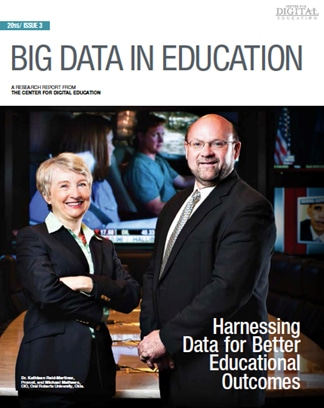In 2015, Oral Roberts University was privileged to be the feature article in the Center for Digital Education Research Report called ‘Harnessing Big Data for Better Educational Outcomes.‘ In August 2016, I was selected to speak at the Global Big Data Conference in Santa Clara, CA, to represent how education leverages Big Data.
The interview of my session describing the tremendous impact that Big Data can have in education can be reviewed here. Without a doubt, Big Data should impact educational outcomes in numerous ways. Oral Roberts University, has been blessed to have numerous technological advances over the past two years that impact educational access and outcomes. These advances range from virtual reality, wearable watches and telepresence robots used to reach into every person’s world; while bringing all data back into the educational environment. Every semester, we are processing terabytes of data transactions that transcend across all campus-wide systems and devices — while seamlessly maintaining data within the security of the Learning Management System (LMS), Student Information System (SIS), and ePortfolio System.
 |
The ability to allow Big Data to improve educational outcomes is directly proportionate to the Campus IT Departments’ ability to integrate all the various systems and devices. Needless to say, Big Data cannot become ‘valuable data,’ if the cumulative data is in separate data silos. Big Data requires seamless integration across all data elements, systems, and devices. I have been fortunate to work at Cray Research for 11 years, and Ellucian for 11 years to gain the expertise necessary to architect the integration of any and all data systems. It has taken 22 years of expertise to see the results that bring educational outcomes from Big Data across a campus-wide enterprise, that has been integrated. |
A Quicker Method to Big Data and Integration
Be encouraged that it no longer takes 22 years of expertise to gain the insights and skills to integrate data systems within education. There are vast improvements that can speed up the integration process of all systems, while maintaining the integrity and security of the data. One of those enterprise improvements is analogous to having the ‘Library of Congress’ for all campus-wide APIs, integration scripts, data methodologies, SSO, and CAS languages all in one cloud based service. That improvement is through a service called Illuminate by N2N Services. There are other such products and services, but N2N focuses primarily on higher education, and comes with 130 ready-to-go integration APIs for SIS, LMS, and other educational systems. We have a partnership with N2N that allows us to now catalog all the integration scripts, APIs, and other services that bring the enterprise seamlessly together. The following video highlights the critical need to integrate all the pieces of the enterprise in order to thrive with Big Data.
Summary
Big Data has positively changed organizations that have successfully integrated all their enterprise data and analytics from an enterprise perspective. Until now, higher education has only dabbled with Big Data and analytics through the improvements of each SIS, LMS, ePortfolio system enhancement. However, if leaders are serious about improving overall educational outcomes, they must approach Big Data and analytics across all campus systems and devices from an enterprise perspective. An enterprise integration approach can happen if a campus has numerous years of data and integration experience, or select an enterprise integration vendor such as N2N. However, it will never happen by solely choosing the APIs and integration of each individual vendor. Many campuses have made it half-way through the enterprise wide integration journey before running out of funding and energy by trying to purchase each SIS or LMS vendors’ integration tools and services.
For Big Data to be leveraged within higher education, it must include all data elements across all campus systems in a seamless and secure fashion.
The ability to allow Big Data to improve educational outcomes is directly proportionate to the Campus IT Departments’ ability to integrate all the various systems and devices. Needless to say, Big Data cannot become ‘valuable data,’ if the cumulative data is in separate data silos. Big Data requires seamless integration across all data elements, systems, and devices. I have been fortunate to work at Cray Research for 11 years, and Ellucian for 11 years to gain the expertise necessary to architect the integration of any and all data systems. It has taken 22 years of expertise to see the results that bring educational outcomes from Big Data across a campus-wide enterprise, that has been integrated.
It is my sincere desire to see people stream-line and shorten the integration process of all their products. For this reason, I recommend getting the decision making data and research that shortens the learning cycle that is available through The Tambellini Group and N2N.
Michael L. Mathews,
Chief Information Officer,
Oral Roberts University.




